Pfaff ClassicStyle Quilt 1527 User Manual

C l a s s i c S t y l e Q u i l t 1527
O w n e r ´ s m a n u a l
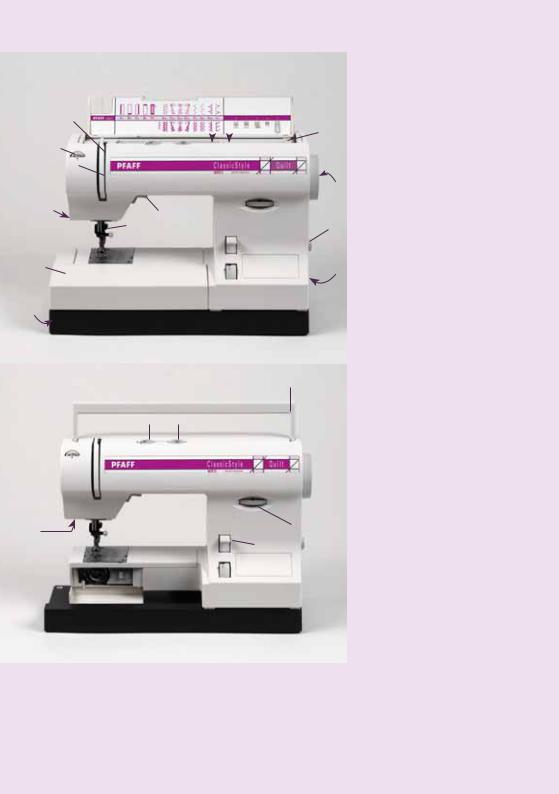
Machine Overview
|
|
|
|
|
|
|
8 7 |
|
|
|
|
||||
9 |
|
|
|
|
|
|
|
|
|
|
|
6 |
|
||
|
|
|
|
|
|
|
|
|
|
|
|||||
|
|
|
|
|
|
|
|
|
5 |
||||||
10 |
|
|
|
|
|
|
|
|
|
||||||
|
|
|
|
|
|
|
|||||||||
|
|
|
|
|
|
|
|
|
|
|
|
|
4 |
||
11 |
|
|
|
|
|
|
|
|
|
|
|
|
|
|
|
|
|
|
|
|
|
|
|||||||||
|
|
|
|
|
|
3 |
|||||||||
12 |
|
|
|
|
|
|
|||||||||
|
|
16 |
18 |
2 |
|||||||||||
|
|
|
|||||||||||||
13 |
|
|
|
17 |
|
|
|
|
|
|
|
|
|
|
|
|
|
|
|
|
|
|
|
|
|
|
|
||||
|
|
|
|
|
|
|
|
|
|
|
|||||
14 |
|
|
|
|
|
|
1 |
||||||||
|
|
|
|
|
|
|
|||||||||
15 |
|
|
|
|
|
|
|
|
|
|
|
|
|
|
|
21
25 26
24 |
|
27 |
22 |
|
23 |
|
|
|
19 |
|
|
|
||
|
|
|
|
|
 20
20
1Connection socket “foot control with main cord”
2Main switch
3Handwheel release disk
4Handwheel
5Bobbin winder
6Lid with stitches
7Extra spool holder
8Spool holder with spool cap
9Take-up lever
10Needle thread tension dial
11Threading path
12Thread cutter
13Presser foot holder with presser foot
14Removable accessory tray
15Base plate
16IDT System / Integrated Dual Feed
17Needle holder with Àxing screw
18Presser foot lifter
19Button for “reverse sewing”
20Stitch length dial
21Carrying handle
22Stitch selection
23Thread guide
24Sewing lamp (max. 15 watt)
25Stitch width dial
26Needle position dial
27Needle plate

Presser feet (normal accessories)
For more information about accessories, please contact your PFAFF dealer.
0Standard Presser Foot with IDT
Part No. 820250-096 (pictured) (select 1546 and 1536)
Part No. 820258-096 (select 1526)
1Clearview Foot
(Fancy-stitch foot without IDT) Part No. 820229-096
3Blindhem/Overlock Foot with IDT
Part No. 820256-096 (pictured) (select 1546 and 1536)
Part No. 820264-096 (select 1526)
4Zipper Foot with IDT
Part No. 820248-096 (pictured) (select 1546 and 1536)
Part No. 820261-096 (select 1526)
5Buttonhole Foot
Part No. 820295-096
0 |
1 |
3 |
4 |
5 |
|
|
|
|
|
1 Felt pad |
6 Seam ripper |
1 |
2 |
3 |
4 |
|
||
|
|
|
|
|
Part No. 93-033 064-05 |
Part No.99-053-016-91 |
|
|
|
|
|
2-4 Spool cap |
7 Brush |
|
|
|
|
|
2. Part No. 93-036 048-44 |
Part No. 93-847 979-91 |
|
|
|
|
|
3. Part No. 93-035 050-44 |
8 Bobbins |
|
|
|
|
|
4. Part No. 93-036 049-44 |
Part No. 93-040 970-45 |
|
|
|
|
|
5 Extra spool pin |
|
|
|
|
|
|
Part No. 93-033 063-44 |
|
5 |
6 |
7 |
|
8 |
|
|
|
|
|
|
|
|
|
Stitches and presser feet
Stitch descriptions are found in the introduction section.

C l a s s i c S t y l e Q u i l t 1527
Discover the fascination of quilting!
Congratulations!
You have purchased a top quality Pfaff sewing/quilting machine with great quilt features.
To learn your C l a s s i c S t y l e Q u i l t 1 5 2 7 , follow the instructions for the select1536.
Your C l a s s i c S t y l e Q u i l t 1 5 2 7 has the same features as the select1536 except from some stitches and accessories. In this manual other accessories are described, they are optional and can be purchased from your Pfaff dealer.
In the image in the fold out page, the stiches and presserfeet included with your C l a s s i c S t y l e Q u i l t 1 5 2 7 are shown.
Some fabrics have a lot of excess dye which can cause
!discoloration on other fabric but also on your sewing machine. This discoloring may be very difÀcult or impossible to remove.
Fleece and denim fabric in especially red and blue often contain a lot of excess dye.
If you suspect that your fabric/ready-to-wear garment contains a lot of excess dye, always pre-wash it before sewing/embroidering to avoid the discoloring.
This household sewing machine is designed to comply with IEC/EN 60335-2-28 and UL1594.
IMPORTANT SAFETY INSTRUCTIONS
When using an electrical appliance, basic safety precautions should always be followed, including the following:
Read all instructions before using this household sewing machine.
DANGER - To reduce the risk of electric shock:
•A sewing machine should never be left unattended when plugged in. Always unplug this sewing machine from the electric outlet immediately after using and before cleaning.
•Always unplug before relamping. Replace bulb with same type rated 15 Watt.
WARNING - To reduce the risk of burns, Àre, electric shock, or injury to persons:
•Do not allow to be used as a toy. Close attention is necessary when this sewing machine is used by or near children or inÀrm persons.
•Use this sewing machine only for its intended use as described in this manual. Use only attachments recommended by the manufacturer as contained in this manual.
•Never operate this sewing machine if it has a damaged cord or plug, if it is not working properly, if it has been dropped or damaged, or dropped into water. Return the sewing machine to the nearest authorized dealer or service center for examination, repair, electrical or mechanical adjustment.
•Never operate the sewing machine with any air openings blocked. Keep ventilation openings of the sewing machine and foot controller free from the accumulation of lint, dust, and loose threads.
•Keep Àngers away from all moving parts. Special care is required around the sewing machine needle.
•Always use the proper needle plate. The wrong plate can cause the needle to break.
•Do not use bent needles.
•Do not pull or push fabric while stitching. It may deÁect the needle causing it to break.
•Switch the sewing machine off (“0”) when making any adjustment in the needle area, such as threading needle, changing needle, threading bobbin, or changing presser foot, etc.
•Always unplug the sewing machine from the electrical outlet when removing covers, lubricating, or when making any other user servicing adjustments mentioned in the instruction manual.
•Never drop or insert any object into any opening.
•Do not use outdoors.
•Do not operate where aerosol (spray) products are being used or where oxygen is being administrated.
•To disconnect, turn all controls to the off (“0”) position, then remove plug from outlet.
•Do not unplug by pulling on cord. To unplug, grasp the plug, not the cord.
SAVE THESE INSTRUCTIONS

Contents
Introduction |
|
Stitch table |
V |
1. Operate your Pfaff select |
|
Electrical connection |
1:2 |
Removable accessory tray |
1:3 |
Bobbins |
1:4 |
Bobbin case |
1:8 |
Threading the needle |
1:10 |
Needle threader |
1:11 |
Bringing up the bobbin thread |
1:12 |
Presser foot lifter |
1:13 |
Thread cutter |
1:12 |
Changing the presser foot |
1:13 |
IDT System/Integrated Dual Feed |
1:14 |
Changing the needle |
1:15 |
Needle thread tension |
1:15 |
Lowering the feed dog |
1:15 |
Stitch width dial |
1:16 |
Needle position dial |
1:16 |
Reverse sewing |
1:17 |
Stitch length dial |
1:17 |
Stitch selection |
1:18 |
2. Utility stitches and practical sewing
Sewing chart |
2:2 |
General sewing aids |
2:3 |
Non-elastic stitches |
2:4 |
Elastic stitches |
2:6 |
Overlockstiche |
2:7 |
Shell edging |
2:8 |
Buttonhole |
2:9 |
Button sewing |
2:10 |
Hemming with the twin needle |
2:11 |
Free Motion Sewing |
2:12 |
Sewing on zippers |
2:13 |
Stabilizing edges |
2:15 |
3. Maintenance and trouble-shooting
Changing the needle plate |
3:2 |
Cleaning |
3:2 |
Replacing the sewing blub |
3:3 |
Trouble-shooting |
3:4 |
IIIIII
Introduction
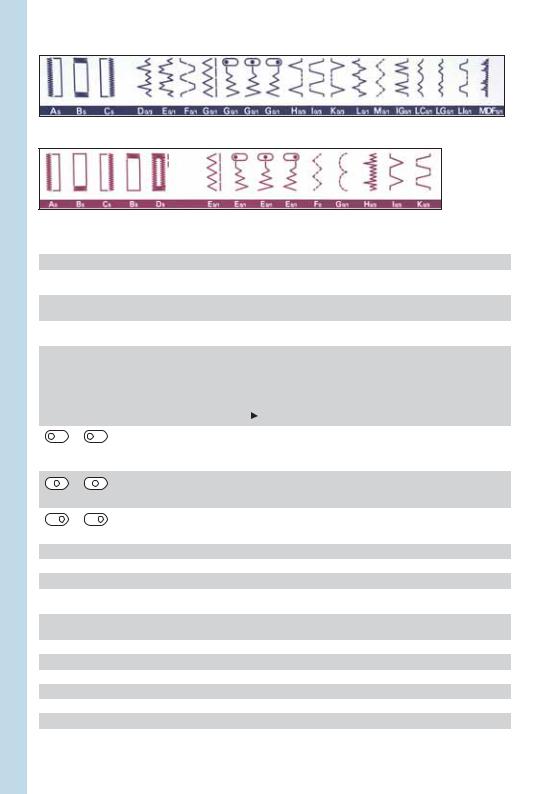
Introduction
Stitch table (non-elastic stitches)
select 1546
select 1536 & select 1526 |
Application |
||||
Stitch |
|
Description |
|||
1546 |
1536/1526 |
|
|
|
|
A/B/C |
A/B/C |
Buttonhole |
Standard buttonhole for blouses or bed linens |
||
D |
H |
Blind stitch with zigzag |
For invisible hemming with simultaneous seam/ |
||
|
|
(elastic) |
overcasting. Especially for stretch material |
||
E |
– |
Greek stitch with zigzag |
A traditional decorative stitch e.g. for towel |
||
|
|
|
|
|
borders |
F |
– |
Scallop stitch |
A traditional decorative stitch e.g. for towel |
||
|
|
|
|
|
borders |
G |
E |
Straight stitch, |
For all straight stitching and topstitching work up |
||
|
|
15 needle positions, stitch |
to 6 mm |
||
|
|
width dial set at 0 |
|
||
|
|
Zigzag stitch, |
For serging and appliqué. Also suitable for |
||
|
|
15 needle positions, stitch |
tapering, eyelet embroidery and cording work |
||
|
|
width dial set at 0.5 – 5 |
|
|
|
|
|
|
|
||
|
|
Left needle position |
Straight stitch: For all sewing and top-stitching |
||
|
|
(for straight stitch and |
operations which require a left needle position. |
||
|
|
zigzag stitch) |
Zigzag stitch: |
||
|
|
|
|
|
For serging, appliqué and tapering. |
|
|
Center needle position |
Straight stitch: For most sewing and top-stitching |
||
|
|
operations. |
operations. |
||
|
|
|
|
|
Zigzag for most zigzag operations |
|
|
Right needle position |
For all sewing and top-stitching operations which |
||
|
|
(for straight stitch and |
require a right needle position. Zigzag stitch: |
||
|
|
zigzag stitch) |
For serging, appliqué, tapering and cording work |
||
H |
– |
Blind stitch |
For invisible hemming on sturdier materials |
||
I |
K |
Greek stitch, wide |
A traditional decorative stitch |
||
K |
I |
Shell-edging stitch |
For Áat overlapped seams |
||
L |
– |
Fancy elastic stitch |
For overcasting, sewing on elastic, darning tears |
||
|
|
|
|
|
and inserting patches |
M |
F |
Elastic stitch |
For overcasting, sewing on elastic, darning tears |
||
|
|
|
|
|
and inserting patches |
IG |
– |
Viennese stitch |
Decorative stitch e.g. for household textiles |
||
LC |
– |
Emperor stitch, narrow |
A dainty decorative stitch |
||
LG |
– |
Emperor stitch, wide |
A dainty decorative stitch |
||
LI |
- |
Greek stitch, narrow |
A traditional decorative stitch |
||
MDF |
– |
Decorative stitch |
A traditional decorative stitch |
||
– |
G |
Decorative stitch |
Decorative stitch e.g. for quilting |
||
IV
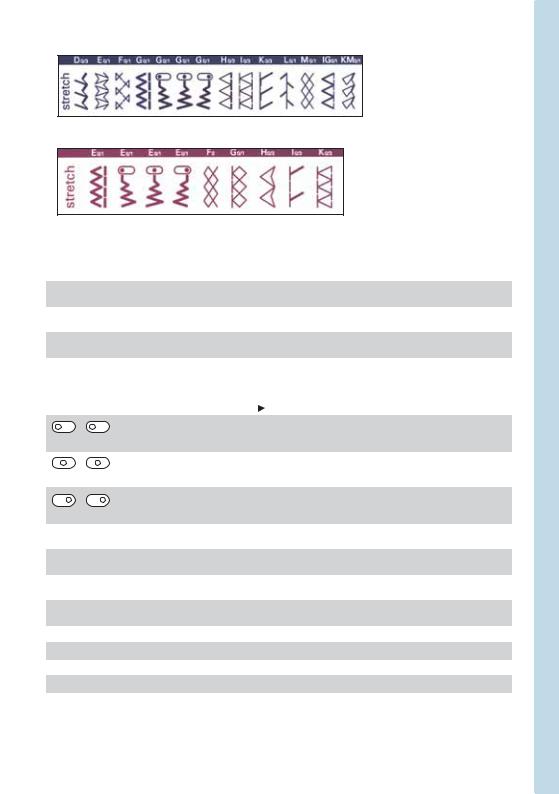
Stitch table (stretch stitches)
select 1546
select 1536 & select 1526 |
|
||||
Stitch |
|
Description |
Application |
||
1546 |
1536/1526 |
|
|
|
|
D |
H |
Peacock’s eye stitch |
Elastic closing and serging seam. The material |
||
E |
– |
|
|
|
must be turned by 180 degrees |
Cover stitch |
For top-stitching and overstitching stretch |
||||
F |
– |
|
|
|
materials, e.g. cuffs, hems and panels |
Herringbone stitch |
A decorative stitch for top-stitching or whip |
||||
G |
E |
|
|
|
stitching hems, e.g. pajamas and sweatsuits |
Stretch triple straight stitch, |
For stretch seams, e.g. inside seams as well as |
||||
|
|
15 needle positions |
seams on sportswear and workwear |
||
|
|
Stretch triple zigzag stitch, |
For sewing elastic bands on elastic materials or |
||
|
|
15 needle positions |
|||
|
|
Stitch width knob 0.5 – 5 |
|
|
seams on stretch materials |
|
|
|
|||
|
|
Left needle position |
For elastic seams which require a left needle |
||
|
|
(for stretch triple straight |
position |
||
|
|
and zigzag stitches) |
|
||
|
|
Center needle position |
For elastic seams which require a center needle |
||
|
|
(for stretch triple straight |
position |
||
|
|
and zigzag stitches) |
|
||
|
|
Right needle position |
For elastic seams which require a right needle |
||
|
|
(for stretch triple straight |
position |
||
H |
– |
and zigzag stitches) |
|
||
Pullover stitch |
Elastic closing and serging seams for jersey. The |
||||
I |
K |
|
|
|
material must be turned by 180 degrees |
Closed overlock stitch |
A closing and serging seam for materials which |
||||
K |
I |
|
|
|
fray easily |
Open overlock stitch |
A closing and serging seam for sturdy materials or |
||||
L |
– |
|
|
|
materials which do not fray easily |
Feather stitch |
For joining two Ànished edges with a gap |
||||
M |
F |
|
|
|
between, e.g. hemstitching. Also for crazy quilting |
Honeycomb stitch |
For sewing on elastic thread, overstitching terry |
||||
IG |
– |
Penant stitch |
A decorative stitch also used as a covering stitch |
||
KM |
– |
Cord stitch |
A loose decorative stitch |
||
-- |
G |
Heavy open overlock stitch |
A closing and serging seam on heavy materials |
||
-- |
H |
Decorative stitch |
Embellishment |
||
VV
Introduction
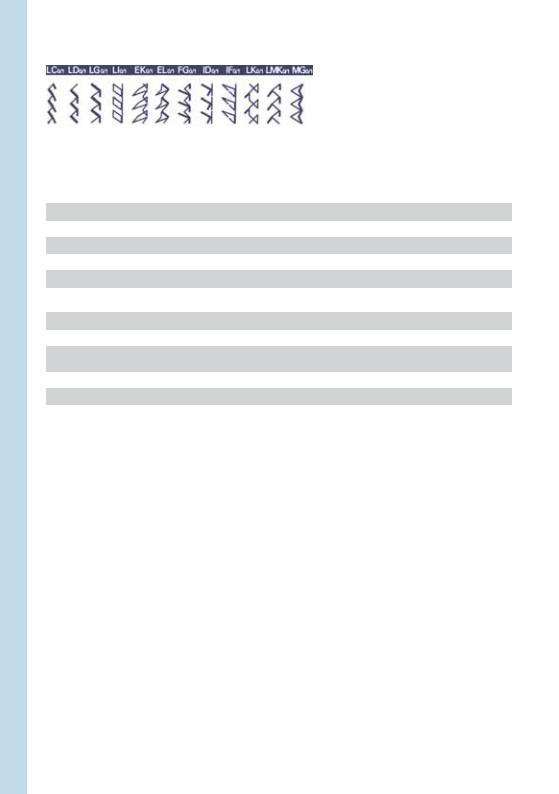
Introduction
Stitch table (stretch stitches)
|
|
|
|
select 1546 |
|
|
|
Stitch |
Description |
Application |
|
1546 |
|
|
|
LC |
Dutch stitch, narrow |
A decorative stitch, e.g. for household textiles |
|
LD |
Dutch stitch |
A decorative stitch, e.g. for household textiles |
|
LG |
Border stitch |
A decorative stitch, e.g. for traditional embroidery |
|
LI |
Weaving stitch |
An ornamental stitch, e.g. for bath accessories |
|
EK |
Spiral stitch |
A decorative stitch, e.g. for household textiles |
|
EL |
Diagonal coverstitch |
For top-stitching and overstitching stretch materials, i.e. |
|
FG |
|
cuffs, hems and panels |
|
Turkish stitch with zigzag |
A top-stitching seam for patchwork and quilting |
||
ID |
Branch stitch |
A decorative elastic stitch, e.g. for sportswear |
|
IF |
Floss stitch |
For whip-stitching hems, e.g. on pajamas and sweatsuits. |
|
LK |
|
The material must be turned by 180 degrees |
|
Diagonal stitch |
An elastic decorative stitch |
||
LMK |
Triangle stitch |
A decorative, elastic stitch |
|
MG |
Florentine stitch |
A stretch, decorative stitch |
|
VI
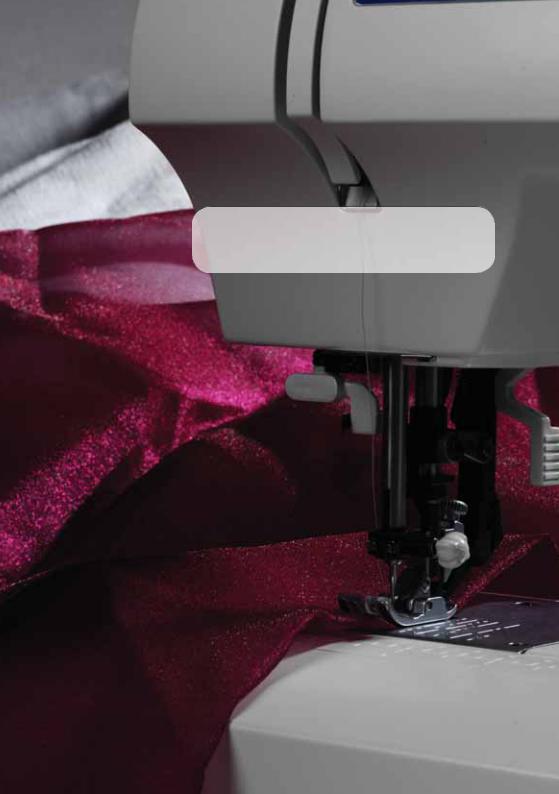
1. Operate your Pfaff select
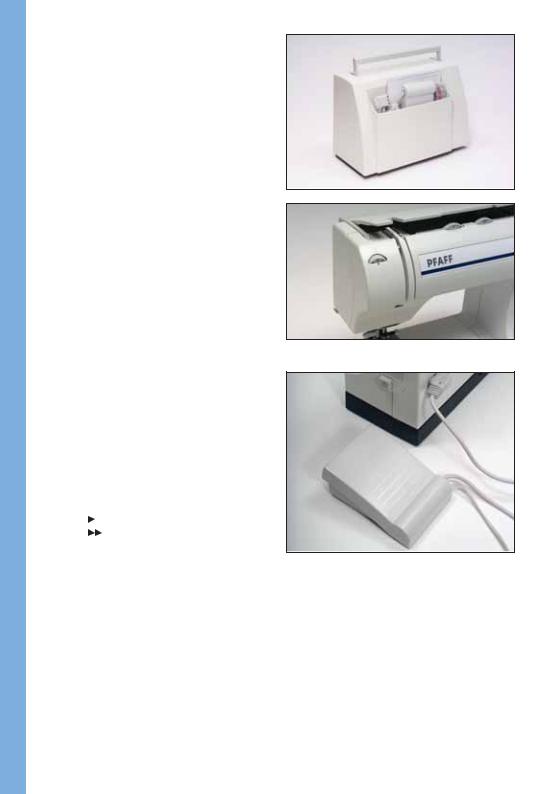
Operate your Pfaff select
Carrying-case
Place the cords, foot control and instruction book in the front pocket of the carrying case.
Lid
Open the folding lid (6) upwards. The stitches of the sewing machine are illustrated on the inside of the lid.
Connecting the foot control
Connect the plug of the foot control to the connecting socket (1) of the sewing machine and to the wall socket. The sewing speed is regulated by pressing the foot control.
You can regulate the sewing speed by moving the slide on the front part of the foot control.
Position |
= half speed |
Position |
= full speed |
AE023 - 120V, USA and Canada AE020 - 230V, Europe
AE024 - 240V, Australia
Main switch
When the main switch (2) is switched on, the sewing bulb lights up. The sewing machine is now ready to use.
1:2
1:2
For the USA and Canada
This appliance has a polarized plug (one blade wider than the other). To reduce the risk of electric shock, this plug is intended to Àt in a polarized outlet only one way. If the plug does not Àt fully in the outlet, reverse the plug. If it still does not Àt, contact a qualiÀed electrician to install the proper outlet.
DO NOT modify the plug in any way.

Accessory tray
Your Pfaff select sewing machine has a removable accessory tray (15) which is also used as an extended work support.
Model 1546, has a special removable accessory organizer. The enclosed accessories are numbered. Sort
the enclosed accessories into the corresponding sections of the accessory organizer.
Using the free arm
In order to sew with the free arm, you must remove the accessory tray. Using both hands, swing the accessory tray (15) to the left and lift it out of the hole.
When replacing the removable accessory tray to its proper position, ensure that it is Áush with the free arm of the sewing machine.
1:3
your Operate
select Pfaff
1:3

Operate your Pfaff select
Preparing the machine for bobbin winding
Hold the handwheel (4) Àrmly and turn the handwheel release disc (3) until it stops in the direction of the arrow. This stops the needle from moving while the machine is winding the bobbin.
Placing the bobbin
Switch off the main switch (2)
Place the empty bobbin so that the black pin of the bobbin winder (5) snaps into the slot of the bobbin. The Pfaff logo is facing up.
Push the bobbin to the right
Note: The bobbin can only be wound when it is moved fully to the right.
1:4
1:4
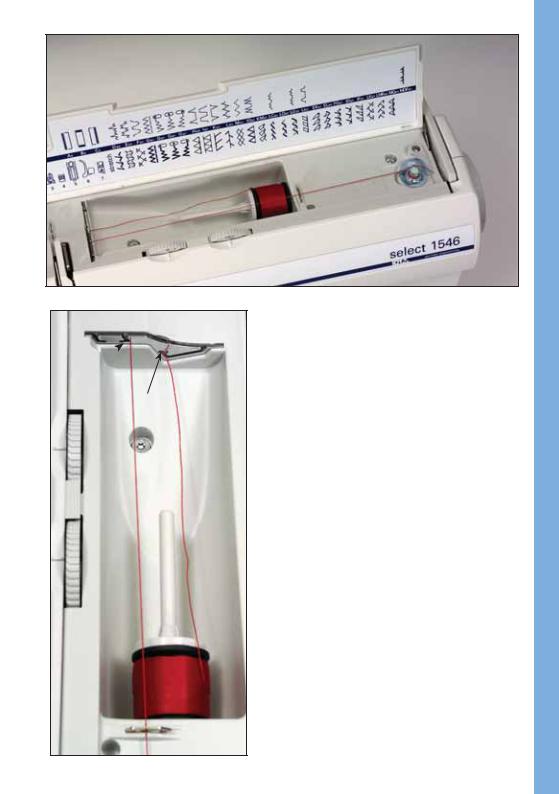
B 
A
C
Winding the bobbin from the spool holder
Place the sewing thread on the spool holder (8). To guarantee free movement of the thread and to give additional hold to the thread spool, Àt a spool cap corresponding to the size of the thread spool.
Threading
Place the thread into guide A and pull it through opening B and to the right under the hook C. Wind the thread clockwise a few times around in the bobbin.
Switch on the main switch.
Hold the end of the thread Àrmly and press the foot control. The winding action will stop automatically as soon as the bobbin is full. Cut the thread, push the bobbin to the left and remove it.
Don’t forget:
Turn the handwheel release disk (3) fully back again. Then turn the handwheel (4) towards you until it snaps into place.
1:5
your Operate
select Pfaff
1:5
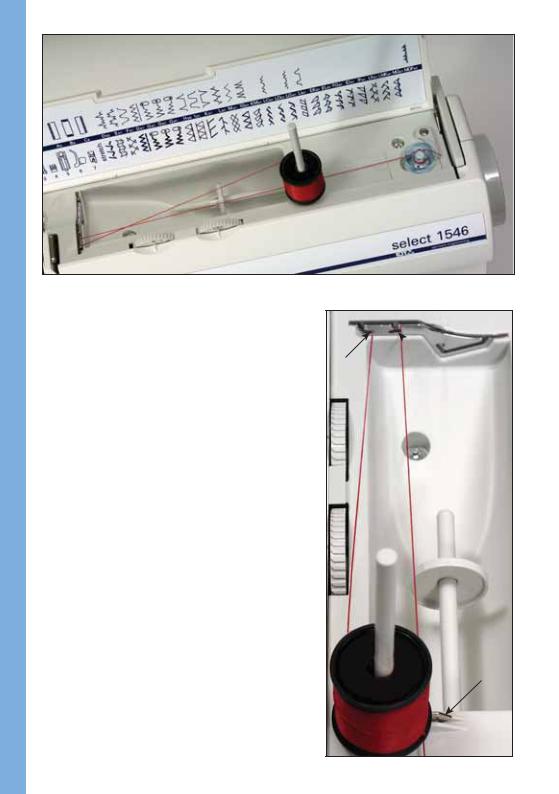
Operate your Pfaff select
Winding from the second spool holder
Push the second spool holder (7) into its hole and place a spool of thread with the corresponding spool cap on it.
Threading
Place the thread into guide A and pull it through opening B to the right under
hook C. Wind the thread clockwise a few times around the bobbin.
Switch on the main switch.
Hold the end of thread Àrmly and press the the foot control. The winding action will stop automatically as soon as the bobbin is full. Cut the thread, push the bobbin to the left and remove it.
Don’t forget:
Turn the handwheel release disk (3) back again. Then turn the handwheel (4) towards you until it snaps into place.
TIP: If the machine is already threaded, you can easily wind thread from the second spool holder without having to unthread the machine.
A  B
B
C
1:6
1:6
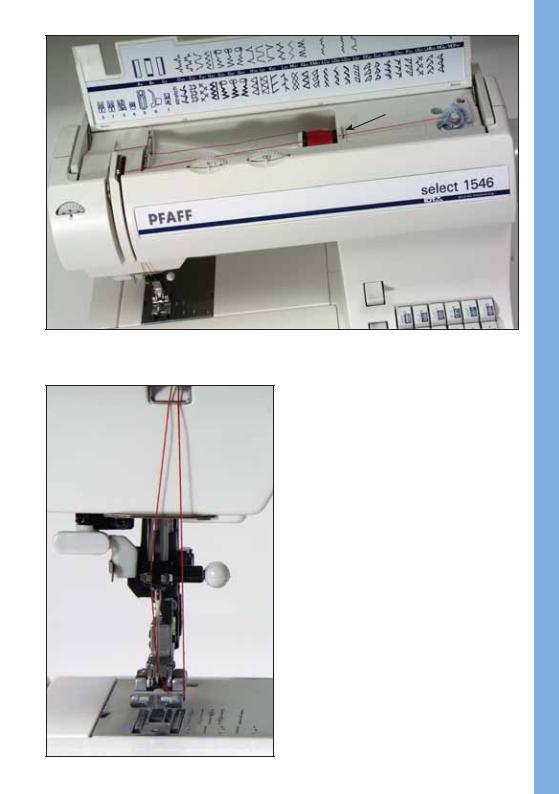
C
Winding through the needle
Even if the machine has been completely threaded, you can still wind the bobbin.
Raise presser foot lifter (19). Pass the needle thread through the presser foot and downwards; then through the right threading slot (11) and upwards.
Now, pull the thread into the take-up lever from left to right (9). The take-up lever must be positioned at its very top.
Pass the thread to the right under the hook C. Then wind the thread several times around the bobbin. Press the foot control and winding the bobbin.
Don’t forget:
Make sure to stop the needle from moving while winding the bobbin (see page 1:4).
1:7
your Operate
select Pfaff
1:7
